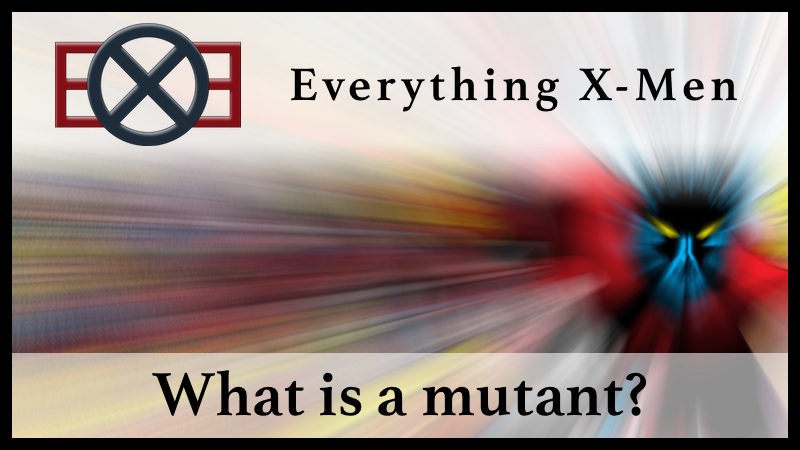
“So maybe I’m an angel and maybe I’m a thief
Maybe I’m a beggar that you walk by on the street
Alright, you cut off both my wings
Sell me for a nickel. The devil’s gotta earn
I don’t need no banker to tell me what I’m wort
It’s alright. Some folks they never learn
You’re eating fire and you’re praying I get burnt”
(“The devil’s gotta’ earn,” Brett Detar)
Mutation is everywhere: “Every single human trait — blue eyes, red hair, cystic fibrosis, a second toe longer than the big toe, and so on — is the result of some genetic mutation somewhere back down the line.” These are the first words of an article discussing different mutations on the website ScienceClarified. This website provides comprehensive definitions of scientific vocabulary, as well as real-life examples of biological phenomenon’s, like mutations. So mutation is not just something abstract and exotic, but an everyday occurrence.
mutation

But before we can discuss the different forms of mutation, one has to have an idea of evolution.
The first one to describe a theory of evolution was the French naturalist Jean-Baptiste Lamarck. He explained a deterministic point of view. For example, the giraffe has a long neck, because it reached for higher leaves, unavailable to other animals. As a result, the neck got longer and longer. This theory was later abandoned, and nearly fifty years later Charles Darwin published his famous book “The Origin of Species by Means of Natural Selection.” With this book, he provided not just a different perspective. His “concept of evolutionary adaptation through natural selection became central to modern evolutionary theory, and it has now become the unifying concept of the life sciences.” (Wikipedia).
The concept of natural selection or survival of the fittest is based on the idea, that one species is more able to survive in an environment and against its competitors, than others. These survivors than mate, and reproduce – they pass their genes to the next generation. Though Darwin did not yet know of the concept of genes, which he acknowledged in his work, he described the idea behind it. Each following generation of a species would be better equipped or able to survive in its environment. If you want to know more about the mechanisms behind natural selection, I highly recommend this article on ScienceClarified: Evolution
But what does this have to do with mutation? Well, because of mutation a species can evolve from one generation to the next. To give you a better understanding of what this concept can mean, I present three different definitions of the word “mutation”:
- Cambridge Dictionary: “an organism that is different from others of its type because of a permanent change in its genes.”
- Wikipedia: “an organism or a new genetic character arising or resulting from an instance of mutation, which is an alteration of the DNA sequence of a gene or chromosome of an organism.”
- Urban dictionary: “A relatively permanent change in hereditary material involving either a physical change in chromosome relations or a biochemical change in the codons that make up genes”
Mutations can occur naturally or can be induced artificially. Natural mutations can be caused when a cell creates an error while duplicating itself, which leads to diseases. Artificial mutations, on the other hand, can be deliberately caused by mutagens – “chemical or physical factors that increase the rate of mutation.” (ScienceClarified, n.d.) Most of those mutagens are human-made, such as drugs, tobacco, or alcohol as well as the exposure to radiation from hydrogen and atomic bombs. But viruses can also be mutagens because they insert parts of their own DNA into host DNA.
As mentioned, mutations can be a cause of natural evolution, create diseases or physical changes of an individual or its offspring. Regarding the human being (but not limited to it), such physical changes can be albinism, the aforementioned red hair, or can cause an altered physical appearance, for example, little persons. This kind of mutation can occur in different forms: one is a very short human but is normal proportioned, another has disproportionate body parts. Another, extreme example is the so-called Elephant-Man: Joseph Merrick.
Mutation is everywhere. It surrounds us and penetrates us. It binds the galaxy together – sorry – got distracted. As I said, mutation is not something abstract and exotic. Besides some extreme radical changes, mostly seen in diseases, mutation and therefore evolution is a slow process. So it seems reasonable to ask a question like the character Charles Xavier did, at the beginning of the second X-Men movie. He asks if the mutants are just “the next link in the evolutionary chain or simply a new species of humanity fighting for their share of the world?” (Arad & Singer, 2003)
the origin of an idea

Either way, the X-Men have extraordinary abilities and are feared because of them. But where did they come from? When did mutants first appear in popular culture? Let’s take a look at their literary origins. There are certain books out there – mostly released at the beginning of the 1950s – which are very similar to the X-Men. Not just regarding their abilities, but also their position in society. “Whether Lee and or Kirby read these works is impossible to tell, but the similarities are significant.” (Darowski, 2011)
I have three examples, which are mentioned time and again if you read something about the origin of the X-Men. I have to say, that unfortunately, I didn’t read the books – yet, at least. So I will just give you a quick overview. To be honest, I didn’t read much comments or reviews about them, because I didn’t want to be spoiled. And yes, I am aware that those books are over 60 years old.
The first book, released in 1953, is Mutant by Henry Kuttner & C.L. Moore. Before the book’s release, the magazine Astounding Science Fiction published first chapters of it. This is also true for Children of the Atom. The book contains five chapters: The Piper’s Son, Beggars in Velvet, The Lion and the Unicorn, Three Blind Mice, and Humpty Dumpty. Those chapters tell different stories of the same characters, in various stages of their adventures. The descriptions of the content sound very familiar and could easily be drawn from an X-Men comic. For example, some of the mutants in the stories want to live peacefully, whereas others want to destroy the human race. Sounds familiar, doesn’t it? As I understand it, most of the mutants can read minds, and the authors are “using italicized type and bracketed paragraphs, [to] effectively convey telepathic conversations amongst several people; one of the book’s major strengths.” (Ferber, 2013) If this last statement doesn’t hook you, I don’t know what else to do.
Children of the Atom by Wilmar Shiras was also published in 1953. Wikipedia states the book as one of “The Most Significant SF & Fantasy Books of the Last 50 Years, 1953-2002.” Unfortunately, the source of this is no longer available, but the statement does its job. The best summary is provided by Arthur Bangs. He also mentions the familiarity of the story with the X-Men – which had their first adventure, just ten years later. Bangs (2005) writes: “This is not a superhero story, but one about gifted children learning to understand and embrace their abilities, and overcoming their sense of isolation by joining together into a community.”
Slan by A.E. van Vogt is the oldest of the three novels – released in 1946. “Slans are evolved humans, named after their alleged creator, Samuel Lann. They have the psychic abilities to read minds and are super-intelligent. They possess near limitless stamina, ‘nerves of steel,’ and superior strength and speed. When Slans are ill or seriously injured, they go into a healing trance automatically.” (Slan, n.d.) The mentioned features could be directly linked to some of the X-Men.
It seems like psychic abilities where very popular in the 40s and 50s. The human being was not enough anymore. There was a need for something more. A need for an idea of the next step. For thousands of years, humans have been the same, and some authors wanted to think about the next steps. Though they are not very likely to occur in real life, some of the abilities like strength or speed, could be achieved by mechanic support systems. Maybe this is also the reason why we build robots or at least try to: to create something better than ourselves.
conclusion
There are many stories, especially from the 1940s and 50s which deal in one way or another with mutations. They deal with the fear of atomic bombs and how they could affect other people. I don’t remember where I read this, but someone said about those books, that most critics don’t like them now because they didn’t predict the right or correct future. But that is an unfair, even strange statement. The primary goal of Science-Fiction is not to tell their audience the future and what will happen in the next ten, twenty or a thousand years. They provide a possibility. How it could be. They are warnings, or bearers of hope, or deal with fears and anxieties. However, first and foremost they entertain. What you make of it, what you read into it or how you interpret those stories is up to you. That is the power of storytelling.
sources
- Arad, A. (Producer), & Singer, B. (Director). (2003). X-Men 2 [Motion Picture]. USA: Twentieth Century Fox
- Bangs, A. (October 23rd, 2005). Children of the Atom by Wilmar Shiras. Retrieved from http://www.sffworld.com/2005/10/bookreview227/.
- Darowski, J. (2011). Reading The Uncanny X-Men: Gender, Race and the mutant metaphor in a popular narrative (doctoral dissertation). Retrieved from https://etd.lib.msu.edu/islandora/object/etd:1030
- Ferber, S. (April 15th, 2013). Mutant: Kuttner & Moore’s final novel. Retrieved from http://www.fantasyliterature.com/reviews/mutant/.
- ScienceClarified (n.d.) Mutation – Real-life applications. Retrieved from http://www.scienceclarified.com/everyday/Real-Life-Biology-Vol-2/Mutation-Real-life-applications.html
- Slan. (n.d.) In Wikipedia. Retrieved September 25, 2017 from https://en.wikipedia.org/wiki/Slan
- Norman, C. (2014). Mutating Metaphors: Addressing the Limits of Biological Narratives of Sexuality. In J.J. Darowski (Ed.), The Ages of the X-Men: Essays on the children of the atom in changing times (pp. 165–177). United States: McFarland & Company, Inc., Publishers.



![[REVIEW] TRANSFORMERS #1-3](https://geekd-out.com/wp-content/uploads/2019/04/tf10-cover-2-1551724212633_1280w-150x150.jpg)